By Peter McCallum, Michael Ruffles and Chantal Nguyen
MUSIC
Blackpink ★★★★
Qudos Bank Arena, until June 17
K-pop juggernaut Blackpink rolled into Sydney determined to obliterate tens of thousands of eardrums.
In between those ears should be big smiles, as South Korea’s biggest girl band and this century’s best answer to the Spice Girls dazzled in the most delightful ways.
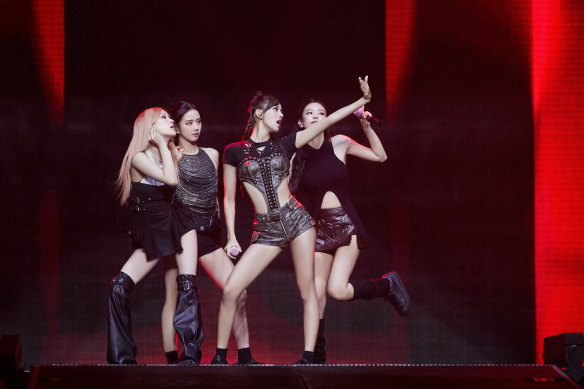
Korean pop superstars Blackpink perform at Qudos Bank Arena.Credit: BLACKPINK, presented by YG ENTERTAINMENT
There were two questions hanging over the night. Would Jennie Kim make it through after illness forced her from the stage at the second Melbourne show on Sunday? And could Blackpink possibly live up to the hype?
The answers were yes, Jennie battled through like a trouper, and “Really, what more do you want?” Chart-topping songs, highly drilled dance routines, pyrotechnics and $90 heart-shaped glow sticks that sync to your phone: it was pop at peak pomp and commerce. Most importantly, it was fun.
Opening with all guns blazing, Jennie, Jisoo, Lisa and Rosé set the bar high and loud early with How You Like That and wasted no time moving into the upbeat Pretty Savage.
The set slipped into teenage heartbreak territory with Don’t Know What to Do and Lovesick Girls, affecting even for those of us who don’t understand the Korean parts and are not exactly the target audience. Formulaic, perhaps, but one that works.
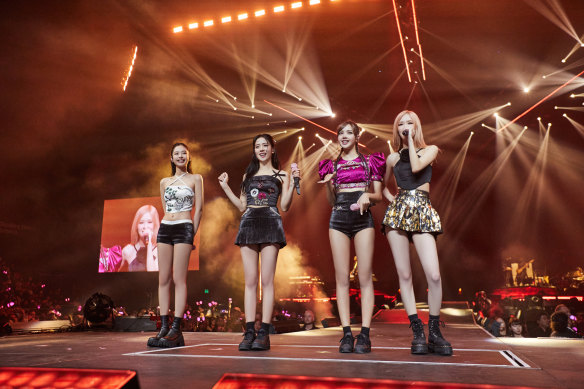
Jennie, Jisoo, Lisa and Rosé speak to the Sydney crowd. Credit: BLACKPINK, presented by YG ENTERTAINMENT
Blackpink share the spotlight evenly, but parts of the songs lean into their various strengths in singing, rapping and dancing. At its best it produces undeniable bangers like the militant break-up anthem Kill This Love, which was among the night’s highlights.
At its weakest, there’s the middling, discombobulated Pink Venom in which everyone gets a turn and the chorus goes nowhere. It was a chart-topper here and elsewhere last year in a triumph of hype over quality, and on the night was carried by the group’s chemistry and enthusiasm. The fireworks didn’t hurt, either, and it moved swiftly into a showcase of the backing dancers and band.
The third act (read: costume change) was dedicated to solos.
Jisoo’s debut offering Flower is a sly, underrated gem about toxic relationships. Jennie perked up for a dance-tastic remix of You & Me. Rosé (the New Zealand-born, Australian-raised one) showed off her vocal chops with a slower medley. And Lisa proved why her star shines the brightest with the irrepressible Money.
Lisa’s boundless energy and infectious smile make her Blackpink’s Sporty Spice, a more naturally magnetic stage presence than her peers throughout the evening. Jisoo and Rosé are sweet and talented, while Jennie had the sick note, but Lisa carried herself like a proper pop star and was able to let loose in the solo section.
The last act and the encore brought out the all-caps favourites DDU-DU DDU-DU and BOOMBAYAH that demand room to dance to, along with the cheerful Forever Young and their best recent single, Shut Down.
It ticked all the boxes and answered the question of why they are the biggest girl group in the world right now. But it did leave me wondering, should I have shelled out 90 bucks for a glorified glow stick?
Reviewed by Michael Ruffles
THEATRE
The Poison of Polygamy ★★★★
Wharf 1 Theatre, until July 8
Not long into The Poison of Polygamy, we realise our narrator, the Preacher (Shan-Ree Tan), is a ghost who was murdered. Adjusting the clerical dog collar under his slit throat, he begins the cautionary tale of our anti-hero, the Chinese villager Sleep-sick (also played by Tan).
No model-minority poster child, Sleep-sick is an empty opportunist named after his opium addiction, abusing his faithful wife Ma (Merlynn Tong) and living only for his next fix.
He sails for the Victorian goldfields where his cynical, grasping materialism contrasts with the humanity of his fellow travellers: the kind, conscientious gardener Chan (Silvan Rus), the forgiving gentle giant Ching (Ray Chong Nee), and the idealistic poet Pan (Gareth Yuen).
Together, they overcome starvation, racism, homesickness, debt and the dangers of mining. But their worlds implode when Sleep-sick takes a femme fatale second wife, the self-proclaimed “rouge tiger” Tsiu Hei (Kimie Tsukakoshi).
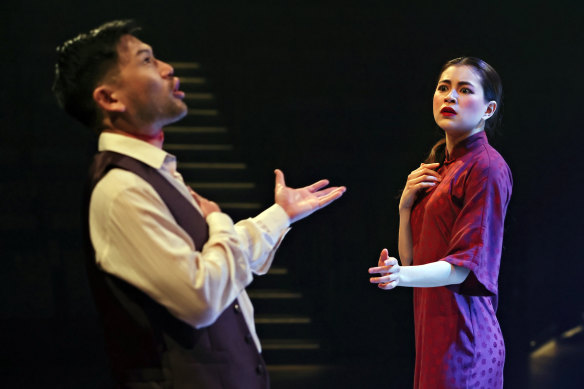
Shan-Ree Tan and Kimie Tsukakoshi star in Sydney Theatre Company’s The Poison of Polygamy.Credit: Prudence Upton
The Poison of Polygamy humanises the early Chinese experience in Australia, and it’s easy to see modern struggles reflected in the characters’ lives and dreams. It’s based on the recently rediscovered 1909 novel by Wong Shee Ping, editor of Melbourne’s Chinese Times and a travelling Christian preacher himself.
In what is lauded as the first Chinese-Australian novel, Wong writes from his own experience of Chinese and Australian society, tackling issues such as discrimination, environmental destruction, women’s rights, marriage, religion and Indigenous issues.
Playwright Anchuli Felicia King keeps Wong’s keen social eye but reshapes his morality. Her Preacher seems existentially lost, and the titular warning about polygamy becomes a caution against neoliberal-capitalist ideals “that a man can take and take and take and there will be no consequences”.
The Poison of Polygamy is worth seeing for its excellent ensemble cast. Tan achieves the seemingly impossible, making Sleep-sick both reprehensible and relatable, lacing his lines with droll comic timing.
Rus, Nee, and Yuen are fine actors, bringing poignant light and shade to their diverse characters. Tsukakoshi is captivating from her first line, giving depth to a character that could easily fall into trope.
Designer James Lew does much with little, using six red pillars that sweep across the stage, and symbolically transitioning costumes from Chinese to Western clothing. Deborah Brown’s choreography evokes everything from martial arts to seasickness to fan dancing.
Finally, Courtney Stewart’s seamless direction makes the play’s long runtime go past in a heartbeat. As the play hurtles towards its devastating conclusion, the overriding impression is of a masterfully acted new treasure of Australian history and identity.
Reviewed by Chantal Nguyen
DANCE
Yuldea ★★★★
Sydney Opera House, until July 15
Yuldea heralds the first production by Frances Rings as Bangarra’s new artistic director, after three decades of Stephen Page’s visionary leadership. Excitingly, the company doesn’t show any obvious withdrawal symptoms. Yuldea is so fresh and uninhibited it almost bursts off the stage.
Yuldea tells a story deeply personal to Rings, set in the home of her matrilineal kin in South Australia’s Wirangu Country. We are introduced to Yooldil Kapi, a sacred waterhole and the powerful epicentre of intertribal trade, cultural, and spiritual life.
Act 1 (‘Supernova’) starts with a light illumining the desert night sky. Leon Rodgers’s cleverly visceral, percussive score propels the dancers with irresistible cosmic force. Diving, shivering, and lifting each other into geometric shapes, their limbs interlock like living puzzle pieces embodying starbursts and galactic orbits. This is Rings at her most striking and abstract, resembling the “science” scenes from her early work Unaipon.
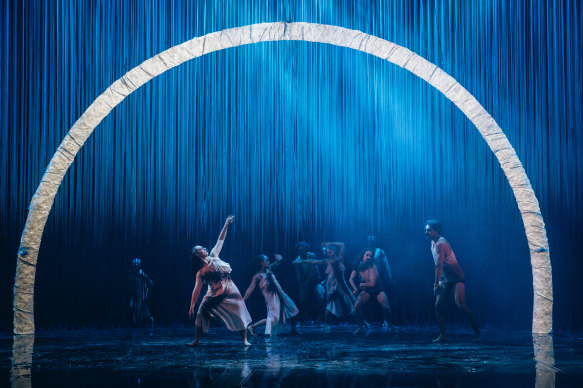
Yuldea explores the moment traditional life collided with the industrial ambition of a growing nation. Credit: Kate Longley
Elizabeth Gadsby’s set design is also arresting: a towering curtain of streamers, suspended from the ceiling and shimmering in an endless play of light and movement. In the first two acts, it looks alive, evoking the silvery desert sky, wind on land, and streaming water.
Against this beautiful backdrop, Act 2 (‘Kapi’ or ‘Water’) gifts us with gorgeously lyrical ensemble dancing. Bangarra’s female ensemble become a flock of delicate water-divining birds, the athletic male ensemble are dingoes, and there are duets for the ethereal Kapi spirit and the red mallee eucalypt. There’s no other dance company that evokes land with such poignancy, and this ability to communicate the beauty of Country remains one of my favourite things about Bangarra. This Act also showcases Jennifer Irwin’s costumes, always a textural marvel and particularly stunning in this production.
In Act 3 (‘Empire’), the curtain becomes a prison wall of industrialisation, turned hard-edged and metallic with glaring LED strips (Karen Norris’s lighting) as the construction of the Trans-Australian Railway runs the waterhole dry.
The devastation culminates in the ‘Black Mist’ scene, recalling the UK’s atomic testing in Maralinga. Shale-like black flakes pours down on a dancer spasming in a cold spotlight. Act 4 (‘Ooldea Spirit’) finally brings us home to Act 1’s skies, with the streamer curtain becoming a celestial backdrop once more as the dancers celebrate the enduring kinship ties that pass on the Yuldea spirit.
It’s a satisfying end to the story, and a fantastic start to Rings’s tenure at the helm.
Reviewed by Chantal Nguyen
OPERA
Rigoletto ★★★½
Sydney Opera House Joan Sutherland Theatre, until June 26
An autocrat who lives by his own rules, treats women as disposable playthings and governs with impunity thanks to the sycophancy of others. Sounds like a normal week in the news.
Yet for all its depressing topicality, this classic production of Verdi’s Rigoletto by the late Elijah Moshinsky, with ingenious revolving set (not to mention a dinky car) by Michael Yeargan, felt more like opera’s past than its future. Elaborate stage artifice engages in diversion, while suppressing, rather than revealing, the work’s contemporary relevance.
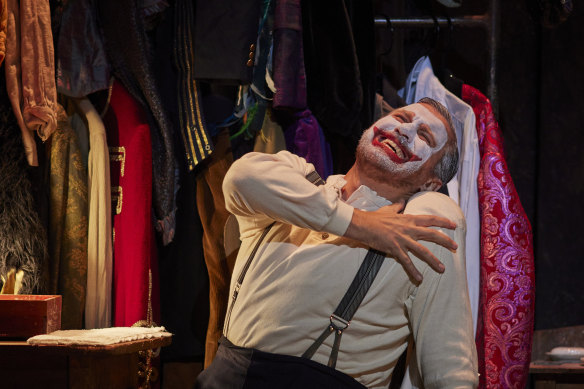
Ernesto Petti starred as the tragic clown Rigoletto in Opera Australia’s Rigoletto.Credit: Keith Saunders
Yet the best moments were rewarding nonetheless, and act two kindled genuine engagement from the audience, thanks to the more urgently timed musical momentum from the orchestra, under conductor Renato Palumbo.
The act two duet between Ernesto Petti, as the tragic self-degraded clown Rigoletto, and Stacey Alleaume, his innocent daughter Gilda, sacrificed to corrupt power, created one of those moments in Verdi where balanced warmth and musical tension capture an essential, unresolvable truth.
Atalla Ayan as the Duke of Mantua had a strong bold sound, particularly attractive in the central register though occasionally slightly open rather than focused. In act three, he began La donna e mobile robustly but aimed for the top B at the close and missed.
As Gilda, Alleaume had a bright polished voice, singing Care nome in act one with coy lyricism. The tone was slightly exposed at the top but true in pitch, with attractively glowing rounded sound in soft notes and piercing strength in ensembles.
In act one, Petti as Rigoletto was best in moments of fierce drama where strength of tone galvanised the complex colours in his voice, though soft notes were a little pale. His first act characterisation could have been darker, but he blossomed dramatically in the later acts.
There was a splendidly malevolent edge to the low notes of Roberto Scandiuzzi’s bass voice in the part of the assassin Sparafucile. David Parkin, in the role of Monterone, delivered the curse that haunts Rigoletto to the end with unwavering force.
Sian Sharp sang with fluid colour and ease as Maddalena in the last act.
The Opera Australia Chorus was cohesively balanced, doing the twist in act one with clumsy awkwardness and acting out with self-lampooning idiocy in act two.
The Moshinsky productions from the last century are something of a treasured heirloom in Opera Australia’s repertoire, but this one would benefit from either more exacting refurbishment or retirement.
Reviewed by Peter McCallum
The Booklist is a weekly newsletter for book lovers from books editor Jason Steger. Get it delivered every Friday.